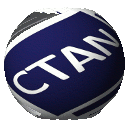Directory graphics/bookshelf
README.md
Bookshelf package by Peter Flynn, with changes by Boris Veytsman
TL;DR
Create your own BibTeX file sample.tex and put its name in spines.tex:
% !TEX TS-program = lualatex % !TEX encoding = UTF-8 Unicode % !BIB TS-program = bibtex \documentclass[landscape]{bookshelf} \begin{document} \nocite{*} \bibliography{sample} \bibliographystyle{bookshelf} \end{document}
luaotfload-tool --update --force bookshelf-listallfonts > allfonts bookshelf-mkfontsel allfonts lualatex spines bibtex spines lualatex spines
License
LPPL 1.3c
Changes
- Version 1.0 2024-10-05. New maintainer. Rewrite of scripts. Multilanguage processing. Important change: now the package is LuaLaTeX only
- Version 1.1 2024-10-08. Scripts now support standard switches –help, –man, –version
- Version 1.2 2024-10-09. Renamed svgnam.tex to bookshelf-svgnam.tex as requested by TeXLive maintainers
Download the contents of this package in one zip archive (10.2M).
bookshelf – Create a nice image from a BibTeX file
This package turns a BibTeX bibliography file into a randomly-coloured, randomly-sized shelf of books, with the title and author in a randomly-chosen typeface.
| Package | bookshelf |
| Version | 1.2 2024-10-09 |
| Licenses | The LaTeX Project Public License 1.3c |
| Copyright | 2020 Peter Flynn |
| Maintainer | Boris Veytsman Peter Flynn (inactive) |
| Contained in | TeX Live as bookshelf MiKTeX as bookshelf |
| Topics | LuaTeX Graphics use Amusements Decoration |
